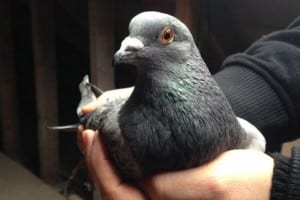 A pair of proteins may hold the key as to how animals like pigeons, sharks and bees sense the Earth’s magnetic field and use it to navigate, scientists say.
A pair of proteins may hold the key as to how animals like pigeons, sharks and bees sense the Earth’s magnetic field and use it to navigate, scientists say.
“This magnetic protein compass may explain how animals can navigate their way,” said lead researcher Dr Can Xie, a molecular biophysicist at Peking University in Beijing.
However another expert is not convinced the finding, reported in today’s issue of the journal Nature Materials, is the key to solving the mystery of how animals navigate.
Scientists have been trying for a long time to work out the biological machinery that enables animals — including pigeons, trout, sharks, bats, turtles, whales and bees — to sense the Earth’s magnetic field and use it for navigation.
Dr Xie and colleagues thought that since a broad range of animals possess this sense, there should be a single “evolutionarily conserved” system that is responsible.
The protein complex spontaneously aligns in the direction of external magnetic fields
Dr Can Xie, Peking University
Previous research has suggested that a light-sensitive protein in the eye called cryptochrome (Cry) plays a key role in magnetic sensing abilities, but Dr Xie and colleagues reasoned it would need to team up with other proteins to actually form a compass.
They screened the genome of fruit flies and discovered an iron-containing protein they dubbed MagR (for magneto-receptor), which can have features of a magnet when polymerised.
“For example MagR forms a rod-like polymer and can orient itself in the direction of a given magnetic field,” Dr Xie said.
He said computer modelling and experiments show how MagR couples with Cry, and that both the MagR polymer and MagR/Cry protein complex can actually respond to magnetic fields.
“The protein complex spontaneously aligns in the direction of external magnetic fields,” Dr Xie said.
“We also showed through immunohistochemical studies biochemical and biophysical methods that the MagR/Cry complex is stable in the retina of pigeons.
“Biochemical and biophysical methods indicated this complex can also forms in butterfly, rat, whale and human cells.
“This is all strong evidence indicators that this biological compass exists in animals.”
Dr Xie said further research was required to understand how Cry was helping MagR to become magnetic, and how signals from the compass were processed by the nervous system.
“To construct an entire and complete explanation of magnetoreception and magnetic navigation may take decades and probably several generations to complete,” he said.
Dr Xie, the discovery of such proteins could be used in the future for manipulating cells and molecules in the human body using magnetic fields.
New Zealand expert prefers the nose to the eyes
However, Professor Michael Walker of the University of Auckland, who has been studying magnetic sensing for decades, is not convinced by the latest findings.
I would back the magnetite hypothesis over the cryptochrome hypothesis
Professor Michael Walker
“It’s a very tentative suggestion,” he said.
“So far as I can tell, the evidence supplied by the researchers is in vitro, not in animals.
“There is no evidence that the correct conditions for the formation of the protein complex actually exists in the eye of animals.”
Professor Walker prefers another hypothesis — that animals navigate using cells in the nose containing crystals of an iron oxide known as magnetite.
He said a large body of research supports this, including experiments in which pigeons that have their noses anaesthetised can no longer navigate properly.
Such research suggests no input from the eyes is required for magnetic sensing.
“I would back the magnetite hypothesis over the cryptochrome hypothesis,” Professor Walker said.
While Dr Xie said that both hypotheses have “credible theoretical and experimental foundations”, Professor Walker said natural selection would make it highly unlikely there is more than one biological compass.
About Pigeon Patrol:
Pigeon Patrol Products & Services is the leading manufacturer and distributor of bird deterrent (control) products in Canada. Pigeon Patrol products have solved pest bird problems in industrial, commercial, and residential settings since 2000, by using safe and humane bird deterrents with only bird and animal friendly solutions. At Pigeon Patrol, we manufacture and offer a variety of bird deterrents, ranging from Ultra-flex Bird Spikes with UV protection, Bird Netting, 4-S Gel and the best Ultrasonic and audible sound devices on the market today.
Voted Best Canadian wholesaler for Bird Deterrent products four years in a row.
Contact Info: 1- 877– 4– NO-BIRD (www.pigeonpatrol.ca)

